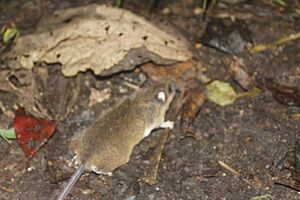Mexican deer mouse facts for kids
Quick facts for kids Mexican deer mouse |
|
|---|---|
 |
|
| Conservation status | |
| Scientific classification | |
| Genus: |
Peromyscus
|
| Species: |
mexicanus
|
| Subspecies | |
|
See text |
|
| Synonyms | |
|
Peromyscus nudipes |
|
The Mexican deer mouse (Peromyscus mexicanus) is a small, furry animal. It belongs to the rodent family, like mice and rats. This mouse lives in forests. You can find it in southern Mexico and many parts of Central America.
Contents
What Does It Look Like?
Mexican deer mice are medium-sized, like typical mice. They have narrow, slightly long heads. Their tails are also quite long. From head to body, they measure about 9 to 12 centimeters (3.5 to 4.7 inches). Their tails are even longer, about 10 to 13 centimeters (3.9 to 5.1 inches).
Their fur is soft and short. It is usually a reddish-brown color. But the color can change depending on where they live. It also changes with the time of year. In dry places or seasons, their fur might be paler. It can range from almost black to light gray.
Their bellies and feet are creamy white. The upper parts of their legs have brown or reddish fur. They have a dark patch near their whiskers. There is also a dark ring around their eyes. The fur on their tail is very thin and short. This makes their tail look almost bare. This is a special feature that helps tell them apart from most other Peromyscus mice.
Where Do They Live?
The Mexican deer mouse lives in warm, tropical areas. These are the lowlands of southern Mexico. They live as far north as San Luis Potosi in the east. In the west, they reach the border of Guerrero and Oaxaca.
They also live in Central America. You can find them in Costa Rica, El Salvador, Guatemala, Honduras, and Nicaragua. They even reach the western border of Panama.
These mice love living in forests. They are more common deep inside forests. They are not as common at the edges of woodlands. They especially like places with limestone cliffs or big rocks. These spots give them lots of places to hide. They are one of the most common mammals in the dense forests of Central America. You can also find them in coffee and cacao farms.
Daily Life and Food
Mexican deer mice make their homes in burrows. They choose spots with good cover. This includes fallen logs, tree roots, or thick plants. In some areas, there can be up to 50 mice in an area the size of a soccer field. But if there is not much food, there will be fewer mice. Each mouse usually roams over an area larger than half an acre.
They are omnivores, which means they eat both plants and animals. They enjoy eating seeds and small bugs. They eat many kinds of seeds. These include plums, mangos, coffee beans, and acorns. They also eat seeds from local plants like those in the tomato and daisy families. For bugs, they mainly eat beetles, spiders, ants, and grasshoppers.
Reproduction and Life Cycle
Mexican deer mice can have babies all year long. A mother mouse carries her babies for about 28 to 32 days. She usually gives birth to one to four young. Most often, she has two or three babies. Right after giving birth, she can get pregnant again.
The young mice start to grow hair around six days old. By this time, they can also crawl around. They can move fully on their own when they are about twelve days old. Adult mice are ready to have their own babies when they are between 46 and 77 days old. However, a female mouse usually only has one or two litters of babies in her whole life.
Conservation Efforts
The Mexican deer mouse is not currently an endangered species. This means it is not at risk of disappearing. Scientists have found that these mice are good "bioindicators." This means they can help show if conservation plans are working well in nature reserves.
Types of Mexican Deer Mice
The Mexican deer mouse belongs to a group of mice called the mexicanus species group. This group is part of the larger Peromyscus genus. Scientists have studied their genes. They found that their closest relatives are other deer mice. These include the Yucatan, Guatemalan, Chiapan, and naked-eared deer mice. They are so similar that they might be very closely related.
There are seven known types, or subspecies, of the Mexican deer mouse:
- P. m. mexicanus - found in Veracruz
- P. m. angelensis - found in the coastal lowlands of Oaxaca
- P. m. azulensis - found in the highlands of Juchitán, Oaxaca
- P. m. putlaensis - found in Putla District, Oaxaca
- P. m. saxatilis - found in Central America
- P. m. teapensis - found in Tabasco
- P. m. totontepecus - found in Sierra Norte de Oaxaca


